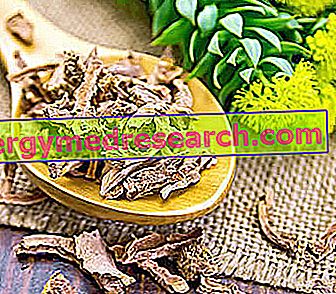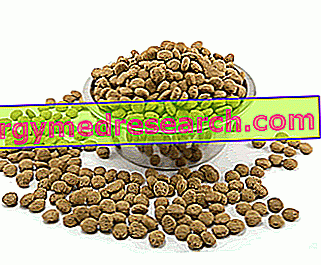The gall bladder stones, as well as those of the bile ducts (of the cystic duct, of the common bile duct but also of the pancreatic duct), represent the most frequent biliary tract disorders and / or complications; moreover, it seems that (in addition to an individual predisposition) both the onset and the prevention of recurrences depend strongly on the subject's diet.

What you need to know
In medicine, gallstones are better known by the term biliary lithiasis ; it is estimated that they affect 6-10% of the general adult population with FREQUENCY NEARLY DOUBLE IN THE FEMALE SEX compared to the male, for a total (in Italy) of about 3, 000, 000 people. In this regard, see the article on epidemiology and risk factors for the appearance of gallstones.
Not all gallstones are the same; regardless of the subjective differences in size and numerosity, it is possible to distinguish TWO main types of gallstones:
- Based on CHOLESTEROL: 75-80% of cases
- A mixed or pigmented base: about 20% (calcium bilirinates, calcium carbonates and phosphates);
of these, some are black and typical of hemolytic or cirrhotic patients, while others are brown and typical of infectious diseases of the gallbladder or parasitic tree.
NB . In western patients, cholesterol-based gallstones prevail. These depend SENSITIVELY on feeding and are formed in three stages:
- Saturation of bile
- Nucleation
- Training
Feeding as a Cause
Diet and formation of cholesterol gallstones
The cholesterol-based gallstones are formed following the alteration of the balance between: CHILITEROL BILIARE (fundamental to the formation of BILE, a chemical digestive juice physically definable as a suspension), BILE SALI and FOSFOLIPIDES. " If the diet is particularly RICH in cholesterol * it is possible that the excess of this lipid-steroid in bile breaks the balance of the suspension" ; to make it short, the alteration of the balance of bile suspension favors the "precipitation" (the deposit) of the cholesterol which subsequently crystallizes to then aggregate and form gallstones.
* See: "Foods with cholesterol"
Another extremely important risk factor, and as the previous one closely related to the subject's diet, is the reduced motility / contractility of the gall bladder. This (which in itself could be pathologically lazy) by contracting shuffles and empties the bile preventing the precipitation of cholesterol. Considering that the gall bladder is stimulated by meals and especially those containing food FATS, it follows that: " a diet characterized by long periods of fasting ... or even simply by long dietary periods in the absence of lipids ... determines the reduction of the motility of the gall bladder that prevents both the mixing and the emptying of the bile (biliary stasis), favoring the precipitation of cholesterol with subsequent formation of gallstones " .
It is also worth mentioning other risk factors for the formation of gallstones dependent on diet: dyslipidemia , diabetes, obesity, estrogen therapies and excessively fast weight loss programs .
Consequences
In most cases, people with gallstones remain long with no symptoms; in a minority of cases, however, post-prandial biliary colic and food vomiting may occur for a duration of 30-180 ', in which it is often necessary to intervene with a pharmacological therapy based on antispasmodics and painkillers. In more serious situations it may be necessary to break-remove the stones or even remove the entire gallbladder (cholecystectomy). NB . The routine examination for the diagnosis of gallstones is abdominal ultrasound.
Feed for gallstones
The first advice to limit the occurrence of gallstones is to return to normal weight; therefore, in conditions of overweight or obesity the NORM slimming caloric therapy becomes necessary. Restart: 25-30% of calories supplied by lipids, 13% from proteins (or 0.75-1.2g of protein per kg of body weight), and the remainder from carbohydrates.
Secondly, the subject's nutrition MUST be aimed at reducing the dysmetabolic conditions mentioned above, therefore useful for re-entry into the normal parameters mainly referred to cholesterolemia, triglyceridemia and glycaemia.
As already specified, the subject's power potentially at risk should NOT be characterized for long periods of fasting, indeed, better if (from an organizational point of view) it is divided into at least 5 daily meals.
It is also advisable that the water balance provided with the food is sufficient to maintain hydration; bile is a suspension and as such is also characterized by an aqueous portion. A state of constant dehydration could promote cholesterol precipitation, therefore it is advisable to treat
- the choice of foods with the greatest amount of water (first course dishes, vegetables and fruit)
- the habit of drinking about 1ml of water for each kcal introduced; for example, in an 1800 kcal diet, at least 1.8 liters of water are required.
Some statistical studies have shown a correlation between a diet rich in refined sugars, poor in dietary fiber, and a high incidence of gall bladder stones. Probably it is an indirect relationship but, to confirm this, it has emerged that diets predominantly vegetarian (which, contrary to what one might think, are NOT hypo-lipidic) are more protective than those with a greater component of food of animal origin .
It should also be taken into account that, in long-term patients (worse if parenterally fed), the contractility of the gallbladder is strongly limited by the scarcity of stimuli induced by nutrition, posture and the absence of physical movement.
Finally, regular physical activity is recommended which, probably due to mechanical and / or chemical stresses, favors the mixing of bile juices.



